Transforming a classic breakfast dish into an indulgent treat, caramel french toast combines the comforting warmth of traditional french toast with the rich, gooey delight of caramel. This fusion not only elevates the breakfast experience but also introduces a versatile dish that can be served as a decadent brunch option or a luxurious dessert. Making perfect caramel french toast at home requires an understanding of the ingredients and techniques that blend together to create this sumptuously sweet dish, ensuring that each bite is a perfect harmony of flavors and textures.

The journey to crafting the perfect caramel french toast involves selecting the right bread—a crucial step that lays the foundation for texture and flavor absorption. Following this, the creation of a smooth, homemade caramel sauce sets the stage for deep, complex flavors that are quintessential to this dish. Preparing the french toast soak and cooking the french toast to golden, fluffy perfection are next, before the pièce de résistance—caramelizing the french toast to achieve that irresistible glaze. Finally, tips on serving and storing caramel french toast ensure that this delicious dish can be enjoyed to its fullest, providing a comprehensive guide for anyone looking to master the art of making caramel french toast at home.
Choosing the Right Bread for Caramel French Toast
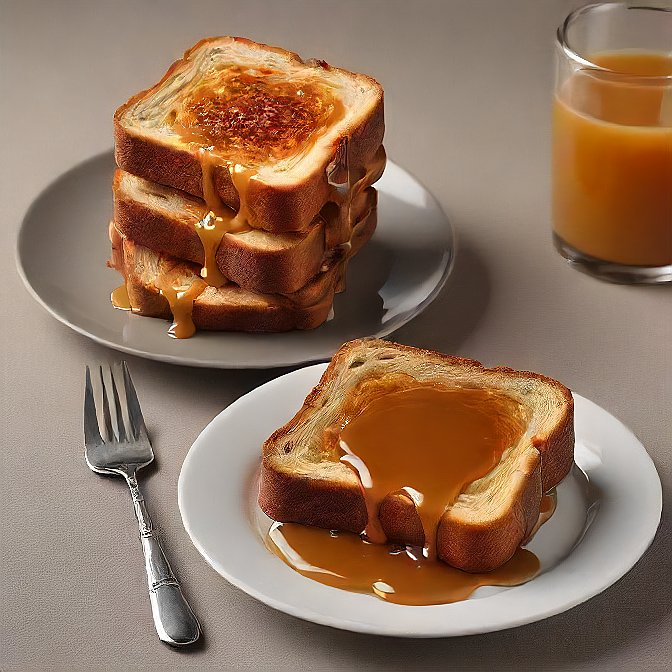
Selecting the ideal bread is a pivotal step in creating the perfect caramel French toast. The choice of bread significantly influences the texture and flavor absorption, crucial for achieving that delightful balance between crisp and custardy.
Sturdiness and Thickness
The bread must be sturdy enough to withstand soaking without disintegrating. Thick-sliced breads like brioche, challah, or a robust Italian loaf are excellent choices. These breads have a dense structure that holds up well against the egg and milk mixture used for soaking. For a truly indulgent experience, brioche is preferred for its rich butter and egg content, which complements the creamy batter perfectly.
Age of the Bread
Opt for bread that is 1-3 days old. Slightly stale bread does a better job of absorbing the batter without becoming soggy. If only fresh bread is available, a quick toasting can help. Toast slices lightly at 300 degrees Fahrenheit for about 12 minutes to enhance their ability to soak up the French toast mixture while maintaining structural integrity.
Bread Type and Flavor
While brioche and challah are top choices due to their rich textures and slight sweetness, other types like sourdough or plain Italian bread can also be used effectively. Sourdough adds a nice tangy contrast to the sweetness of the caramel, and its firm texture ensures it holds up well during cooking. For those who prefer a subtler flavor, pain de mie offers a neutral taste and a sponge-like texture that absorbs flavors beautifully.
When cutting the bread, aim for slices about 3/4-inch thick. This thickness ensures that the bread can soak up enough batter to become custardy inside, while still being thin enough to cook through and caramelize on the outside. Always avoid very thin or airy slices, as they are likely to fall apart or become overly soggy.
In conclusion, the bread chosen for caramel French toast should be slightly stale, thickly sliced, and sturdy enough to handle generous soaking. Whether one opts for the luxurious brioche, the slightly sweet challah, or the tangy sourdough, the right bread will elevate the caramel French toast to a decadent culinary delight.
Making the Caramel Sauce
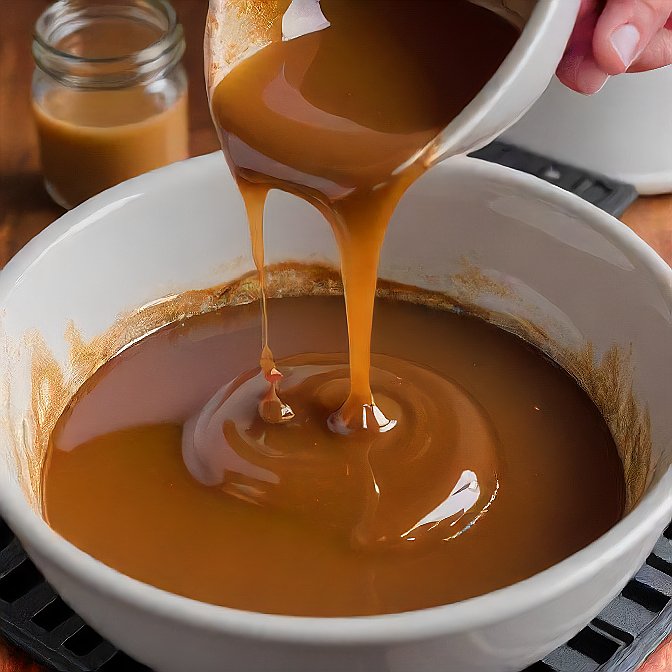
Ingredients
To create the caramel sauce for the caramel French toast, gather the following ingredients:
- 150g brown sugar
- 250ml heavy cream
- 50g butter
- 1 teaspoon vanilla extract
- 1/2 teaspoon of salt
Instructions
- Prepare the Saucepan: Heat a saucepan over medium heat to start the caramel sauce preparation.
- Combine Ingredients: Add the brown sugar, heavy cream, butter, salt, and vanilla extract into the heated saucepan.
- Simmer: Allow the mixture to simmer, stirring occasionally. This process should take about 5 minutes, or until the sugar and butter have completely melted and the mixture is smooth.
- Cooling and Storing: After the caramel sauce has formed, remove the saucepan from the heat. Allow the sauce to cool before transferring it to a jar. If the caramel sauce is not used immediately, it should be refrigerated.
This homemade caramel sauce will add a rich, gooey layer to the French toast, enhancing its flavor and making it a delightful treat.
Preparing the French Toast Soak
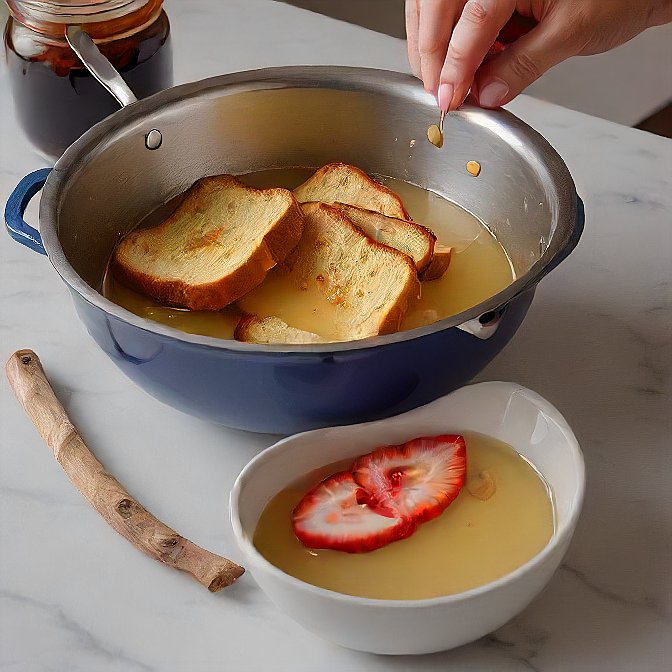
Ingredients
To prepare the soak for the caramel French toast, gather the following ingredients:
- Eggs
- Milk or cream (whole or heavy cream preferred for richness)
- Vanilla extract or vanilla bean paste
- Sugar or maple syrup (optional for added sweetness)
- Cinnamon powder (optional for a spiced flavor)
Instructions
- Mix the Batter: In a large bowl, whisk together the eggs, milk, and vanilla extract. If using, add sugar or maple syrup and cinnamon powder to the mixture. Ensure all ingredients are well combined to form a smooth batter.
- Prepare the Bread: Place the bread slices in a deep dish tray. It’s beneficial if the slices fit snugly to ensure even soaking.
- Soak the Bread: Pour the batter over the bread slices, making sure each piece is fully coated. For optimal absorption and flavor, allow the bread to soak in the batter for at least 2 hours, or ideally overnight. This ensures the bread fully absorbs the liquid, enhancing the flavor and achieving a custard-like center upon cooking.
- Ensure Even Soaking: To guarantee even soaking, flip the bread slices halfway through the soaking period if possible. This step is crucial to prevent dry spots and ensure that each bite is uniformly moist and flavorful.
Cooking the French Toast
To achieve perfectly cooked caramel French toast, begin by heating a nonstick pan or skillet over medium heat. If opting for a nonstick pan, a small amount of butter can be added to prevent sticking and add a slight richness to the toast.
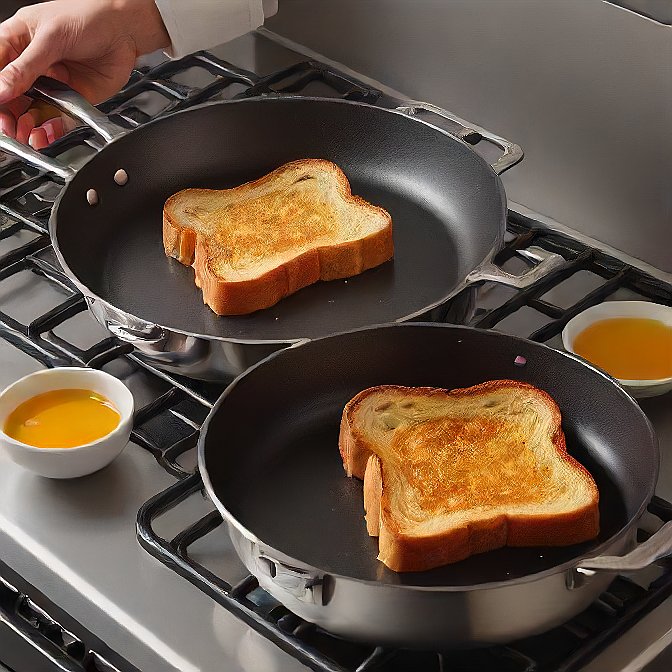
- Prepare the Pan: Turn the stove or electric heater to medium-high and add non-stick spray or butter to the pan. This ensures that the bread does not stick and gains a beautiful golden crust.
- Cook the Bread: Place the soaked bread slices onto the pan without overcrowding—typically two slices at a time work best. This allows for even cooking and easy flipping. Cook each slice for about 2 to 3 minutes on each side. The goal is to achieve a light brown color on both sides, with the edges slightly darker if preferred.
- Manage Cooking Time: Monitor the toast as it cooks, adjusting the heat if necessary to prevent burning. The exact cooking time might vary slightly depending on the thickness of the bread and personal preference for doneness.
- Serving or Storing: Once cooked, the French toast can either be served immediately or placed on a plate in a warm oven. If keeping warm in the oven, do not leave for more than 30 minutes to maintain optimal texture and warmth.
By following these steps, one ensures each slice of caramel French toast is perfectly caramelized and ready to be enjoyed with the homemade caramel sauce and additional toppings as desired.
Caramelizing the French Toast
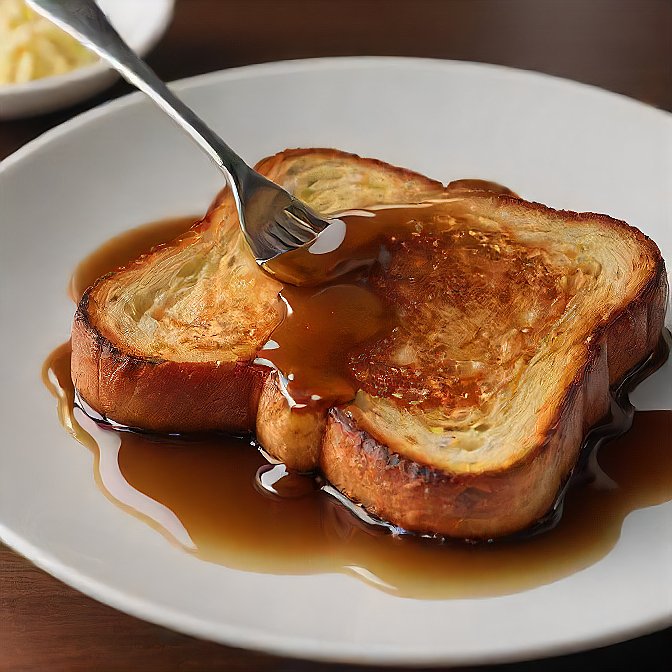
After all the bread slices have been cooked and removed from the pan, the next step is to create the caramel glaze that defines this dish. Start by adding brown sugar directly to the same pan. Stir the sugar until it melts and becomes sticky, which forms the base of your caramel sauce. To this, add a small amount of water to help dissolve the sugar completely and create a smooth, rich sauce.
Once the caramel sauce is ready, place the cooked French toast slices back into the pan. Carefully turn each slice in the caramel sauce to ensure they are fully coated on both sides, giving them a deliciously sweet and glossy finish. This process should be quick to avoid over-soaking, which can make the toast soggy.
For those seeking an extra touch of gourmet, inspired by a technique shared by a French cook, sprinkle about a half tablespoon of granulated sugar on the top side of the bread before flipping it in the pan. This method allows the sugar to caramelize directly on the bread, forming a crackly, brûlée-like crust that is both visually appealing and delightful in texture.
Continue by frying the sugar-coated side until golden brown, which typically takes about 2 minutes. Ensure the pan is well-coated with a mix of oil and butter to prevent the toast from sticking while achieving a perfect caramelization. Once the first side is done, sprinkle another half tablespoon of sugar on the already cooked side and flip it again to lightly caramelize the first side. This double caramelization technique ensures a crispy, sweet exterior while maintaining a soft, fluffy center.
Through these steps, the French toast not only gains an irresistible caramelized crust but also enhances the overall flavor profile, making it a truly indulgent treat.
Serving and Storing Caramel French Toast
To serve caramel French toast at its best, drizzle the freshly made caramel sauce over the toast just before serving. This ensures that each slice is warm and the caramel is delightfully gooey. For an added treat, consider pairing with maple syrup or a sprinkle of powdered sugar.
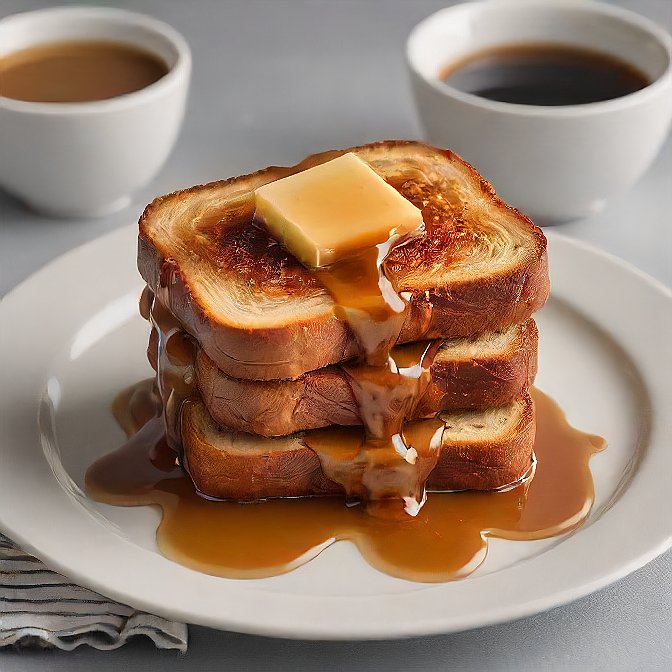
Storing Leftover French Toast
Proper storage is key to maintaining the quality of leftover caramel French toast. Here are effective methods to ensure it remains delicious:
- Refrigeration: Store the French toast in an airtight container or resealable bag in the refrigerator. Place a sheet of wax paper between each slice to prevent them from sticking together. This method is ideal if you plan to consume the leftovers within a few days.
- Freezing: For longer storage, arrange the French toast slices in a single layer on a baking sheet and freeze until firm. Then, transfer the slices to a freezer-safe bag or container. This prevents the slices from sticking together and allows for up to 2-3 months of storage.
Reheating Leftover French Toast
When ready to enjoy, the French toast can be reheated to restore its warmth and texture:
- Toaster or Toaster Oven: This method helps retain the crispiness of the exterior. Simply place the slices in the toaster or toaster oven until warmed through.
- Microwave: For a quicker option, microwave the French toast. However, this may soften the texture.
- Oven Reheating: Preheat the oven to 350 degrees Fahrenheit and place the toast on a wire rack over a baking sheet. Heat until the toast is warm, about 5-10 minutes.
Remember to store any toppings, like fruits or whipped cream, separately to avoid making the toast soggy. By following these storage and reheating tips, you can enjoy caramel French toast at its best even days after preparation.
Conclusion
Through the exploration of selecting the perfect bread, making homemade caramel sauce, preparing the french toast soak, and mastering the art of caramelization, we have delved into the nuances that transform good french toast into an extraordinary culinary experience. The rich, decadent journey of caramel French toast does not just end with the cooking process but extends into serving, storing, and reheating to ensure every bite maintains its indulgent quality. By adhering to the recommendations on bread choice, bread preparation, and caramel sauce creation, enthusiasts and gourmets alike can elevate their breakfast or dessert table with a dish that balances the warmth of traditional French toast with the luxuriousness of homemade caramel.
The significance of this dish extends beyond its mouth-watering appeal, embodying the joy of cooking and sharing homemade delights with loved ones. The versatility of caramel French toast, serving as both a lavish breakfast option and a sumptuous dessert, underscores its place in the realm of comfort food. For those who have embarked on this culinary journey, the outcomes are rewarding, offering not just a meal but an experience enriched with flavors, textures, and the sweetness of caramel. As we conclude, it’s evident that the art of making perfect caramel French toast at home is a testament to the beauty of blending simple ingredients with precise techniques to create something truly spectacular.
FAQs
1. How can you prevent French toast from becoming soggy?
To avoid soggy French toast, it is essential not to soak the bread too long. Use thicker slices of bread, which absorb the egg mixture well without becoming too wet. Additionally, cooking at the right temperature ensures the bread is cooked thoroughly without retaining excess moisture.
2. What is the optimal soaking time for French toast before cooking?
The ideal soaking time for French toast can vary, but generally, it should be brief, especially if you are using thinner slices of bread. Aim for about 30 seconds to one minute on each side, ensuring the bread is moist but not overly saturated.
3. Why doesn’t my French toast become crispy?
If your French toast isn’t getting crispy, consider the cooking environment and method. Avoid overcrowding the pan and cook in batches if necessary to give each slice ample space to crisp up. Use medium-low heat to balance cooking the inside to a custard-like consistency while crisping the outside without burning.
4. What causes French toast to lack fluffiness?
Fluffiness in French toast can be influenced by several factors including the type of bread used, the egg-to-milk ratio in the batter, and the soaking time. To achieve fluffier French toast, use thicker slices of soft, airy bread like brioche or challah, and ensure an adequate soak to allow the bread to puff up during cooking.
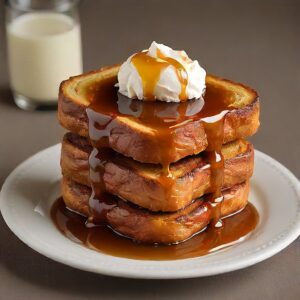
caramel french toast
Ingredients
- 1 cup brown sugar
- 1/2 cup butter
- 2 tablespoons light corn syrup
- 1/2 teaspoon ground cinnamon
- 1/4 teaspoon ground nutmeg
- 1/4 teaspoon salt
- 1 loaf of French bread sliced into 1-inch thick pieces
- 6 large eggs
- 1 1/2 cups milk
- 2 teaspoons vanilla extract
Powdered sugar
Fresh berries
Instructions
- Preheat oven to 350°F (175°C).
- In a saucepan, combine brown sugar, butter, and corn syrup. Cook over medium heat until the mixture is smooth and bubbly.
- Pour the caramel mixture into a 9×13-inch baking dish.
- Arrange the slices of French bread in the baking dish on top of the caramel sauce.
- In a bowl, whisk together eggs, milk, vanilla extract, cinnamon, nutmeg, and salt.
- Pour the egg mixture evenly over the bread slices.
- Cover and refrigerate for at least 30 minutes, or overnight if desired.
- Bake uncovered for 25 minutes, or until the bread is golden brown and the custard is set.
- Let it cool slightly before serving.
- Serve warm, topped with powdered sugar and fresh berries if desired.

Leave a Reply